Increase Your One-Rep Max With This Strength Workout Plan
Do these three sessions for four-weeks to test your top-end strength and lift more weight than ever before
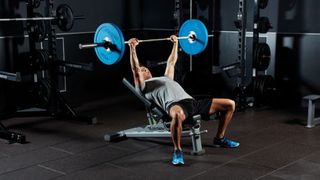
If you want to get serious about strength, you need to know your one-rep max (the most amount of weight you can lift for a single rep) in the big moves. Building up to testing your limits involves doing low-rep sets, which will increase your strength and test your central nervous system in a way that, over time, will improve the way you recruit muscle fibres. That has the happy effect of helping you get bigger and stronger. But before you start, here’s our experts’ advice on how to go big.
Squat “Aim to do every rep of your squat – warm-up or working set – the same,” says powerlifter Tom Hamilton. “Grab the bar the same way, take the same number of steps out of the rack – ideally it should be three – and go through the same mental cues before you lift. When the weight gets heavy, you’ll go back to what you’ve done a hundred times.”
Deadlift Remember: if you aren’t scraping your shins, you aren’t really trying. “An easy way to do it is to take hold of the bar then ‘pull’ yourself down into position, rolling the bar against your shins so that your toes are well underneath it,” says strength coach Joel Dowey. “Take the tension of the bar before you lift, and imagine pulling your shoulder blades back and down into your pockets to keep your back tight.”
Bench press For a better bench, the set-up is key. Get into position with your hands wide enough to leave your arms at a roughly 45° angle from your sides, with your forearms vertical as you press. “Get a hand-off from a spotter if you can,” says Dowey. “This’ll allow you to pull your shoulder blades together behind you before you take the bar, giving you a more stable base to press from.”
How to do these workouts
Follow the sets, reps and rest instructions for each move to get the maximum benefit. Do each workout once a week for four weeks, aiming to increase the amount you lift each week – and make sure you note how much you lift in each session to track your progress and keep yourself motivated. When you get to the final week you’ll test your one-rep max by doing an extra single-rep set on the main move in the workout.
Workout 1: Back Squat Max
Do the sets and reps as described in the first three weeks then, for week four, do an extra single-rep back squat set where you lift as much weight as possible. If you fail, drop the weight by about 5% and have one more attempt.
1 Dumbbell jump squat
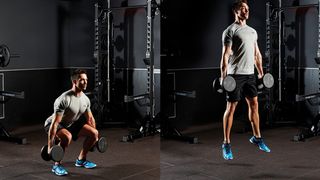
Sets 3 Reps 5 Rest 60sec
Get the Coach Newsletter
Sign up for workout ideas, training advice, reviews of the latest gear and more.
Why This explosive move will activate your fast-twitch muscle fibres, priming your nervous system so you get maximum muscle fibre recruitment. The rep count is low because this is about quality of movement rather than exhausting your target muscles.
How Stand with feet shoulder-width apart, holding a dumbbell in each hand. Squat down, then explode up to jump as high as you can. Land softly and go straight into the next rep.
2 Back squat
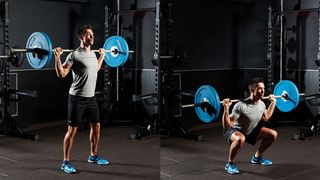
Sets 4 Reps 5, 4, 3, 2 Rest 3min
Why The king of the legs moves works your entire lower body and, when you go really heavy, turns into a whole-body move because it recruits your entire upper body to control your torso and prevent your body from slumping. It’s a really useful, functional exercise so, if your mobility permits it, you’d be wise to make it a cornerstone of your training programme.
How Rest the bar on your back with your feet roughly shoulder-width apart, toes pointing out slightly. Keep your spine in alignment by looking at a spot on the floor about two metres in front of you, then sit back and down as if you were aiming for a chair. Lower until your hip crease is below your knee. As you drive back up, keep your weight on your heels.
3 Incline bench press
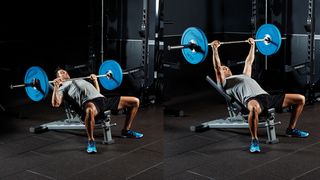
Sets 3 Reps 10 Rest 60sec
Why Setting the bench to an incline will mean you need to reduce the weight, but it’ll help to develop shoulder stability.
How Lie on a bench set at a 45˚ incline, holding a bar over your chest with your hands just wider than shoulder-width apart. Lower the bar until it’s touching your chest, then press back up.
4 Incline dumbbell press

Sets 3 Reps 6-8 Rest 60sec
Why This is similar to the barbell version but it allows you to squeeze a bit more work out of your muscles safely once you have completed the previous exercise. It will also challenge the stabilising muscles around the shoulder joint.
How Lie on a bench set at a 45˚ incline, holding a dumbbell in each hand with your arms straight up. Lower the weights to chest height, keeping your elbows close to your sides, then press back up to the start.
5 Diamond press-up

Sets 3 Reps 6-8 Rest 60-90sec
Why This is a deceptively tough exercise. Moving your hands close together to form a diamond shape will put a lot more emphasis on your triceps. Don’t be surprise if you struggle to hit the rep count if you’re new to this exercise – just focus on maintaining good form.
How Get into a press-up position, placing your hands close together so your thumbs and index fingers touch. Keeping your body in a straight line with your abs braced, lower your torso until your chest is just above the floor, then press back up.
See related
- Six-Week Strength Training Workout Plan
- The Best Free-Weights Workout Plan To Build Strength
- 7 Essential Barbell Exercises To Get Stronger
Workout 2: Deadlift Max
Do the sets and reps as described in the first three weeks then, for week four, do an extra single-rep deadlift set where you lift as much weight as possible. If you fail, drop the weight by about 5% and have one more attempt.
1 Kettlebell sumo deadlift
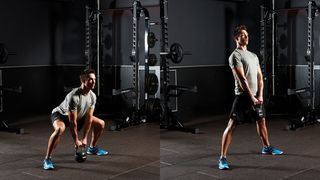
Sets 3 Reps 10 Rest 60sec
Why This version of the deadlift is a good way of drilling a movement pattern that requires you to engage your hamstrings and hinge at the hips. You’re using a fairly light weight so it won’t fatigue your muscles before you get to the heavy deadlift sets in the next exercise.
How Taking a wider stance than in a regular deadlift, place the kettlebell between your legs. Start the movement by straightening your legs without changing the angle of your torso. Once your legs are straight, push your hips through to straighten up.
2 Deadlift
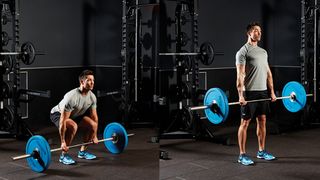
Sets 4 Reps 5, 4, 3, 2 Rest 3min
Why The deadlift is arguably the most effective whole-body strength and muscle builder. It also focuses on your posterior chain – the muscles on the back of your body, which often end up undertrained but play a key role in promoting good posture and keeping you injury-free.
How Set up so you grasp the bar with an overhand grip , hands just wider than shoulder-width apart. Initiate the movement by loading your hamstrings and straightening your knees. Once the bar is past your knees you can straighten up fully.
3 Kettlebell goblet squat

Sets 3 Reps 10 Rest 60sec
Why If you focus on touching your elbows to your knees, this will build the mobility you need for full-depth squatting, as well as flexibility in your groin and ankles, which makes it an ideal warm-up move.
How Hold the kettlebell with both hands in front of your chest, and squat down with your back straight and chest up. Descend until your elbows touch the insides of your knees, then put your weight on your heels as you stand back up.
4 Front squat

Sets 3 Reps 10 Rest 60sec
Why Shifting the bar in front of you moves the emphasis to your quads but also makes the move safer - you’ll be less likely to tip forwards and injure your lower back.
How Take the bar out of the rack so it’s resting on the front of your shoulders with your palms facing upwards. Squat down, keeping your chest up, then drive up through your heels to stand.
5 Bulgarian split squat

Sets 2 Reps 6-8 each side Rest 60sec
Why This variation of the squat will target your quads – a key muscle group involved in heavy squats. It also works your legs independently so that you are equally strong and stable on both sides.
How Start with your back foot on a bench and your front foot approximately 60cm in front of the bench, holding a dumbbell in each hand. Bend at the knee to lower towards the floor, keeping your torso upright, then press back up to the start. Make sure that your knee is in line with your ankle and that your front foot is far enough forwards that your knee doesn’t travel in front of your mid-foot. Complete all the reps on one side, then switch.
Workout 3: Bench Press Max
Do the sets and reps as described in the first three weeks then, for week four, do an extra single-rep bench press set where you lift as much weight as possible. If you fail, drop the weight by about 5% and have one more attempt.
1 Dumbbell bench press

Sets 3 Reps 10 Rest 60sec
Why The workout starts with the dumbbell version of the main move to warm up the target muscles and also activate the small stabilising muscles around the shoulder joint, which you’ll need to recruit if you want to go heavy on the barbell lift that’s up next.
How Lie on a bench with your feet on the floor directly underneath your knees, holding the dumbbells above your chest. Lower them to your chest, then drive your feet hard into the floor and push the dumbbells back strongly to the start position.
2 Bench press
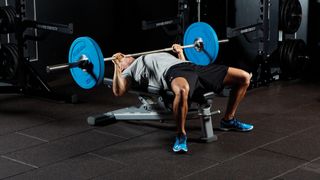
Sets 4 Reps 5, 4, 3, 2 Rest 3min
Why It’s a classic for a reason: a properly executed bench press (your feet should be pressing into the floor) will tax your whole body and allow you to use heavy weights to maximise upper-body development. Ensure your form is correct to avoid injury and maximise growth.
How Grip the bar with hands slightly wider than shoulder-width apart and squeeze your lats together to create a pressing platform before you take the bar out of the rack. Watch the ceiling, not the bar, to ensure you’re pressing in the same line each time. Lower the bar to your chest, aiming to brush your T-shirt without bouncing. Press up powerfully, pause at the top, then go into your next rep.
3 Romanian deadlift
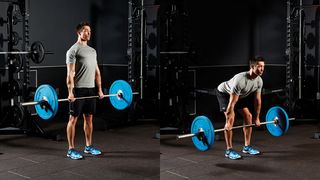
Sets 3 Reps 10 Rest 60sec
Why This is an ideal way of developing the hamstring strength needed to improve your deadlift. It’s technically a lot easier than the deadlift so you’ll be able to go reasonably heavy even when your muscles are tired.
How Hold a barbell with an overhand grip just outside your thighs. Hinge at the hips to send the bar down the front of your thighs, ensuring that the bar stays close to you throughout the lift. Lower until you feel a strong stretch in your hamstrings, then straighten back up, contracting your glutes at the top of the move.
4 Snatch-grip deadlift
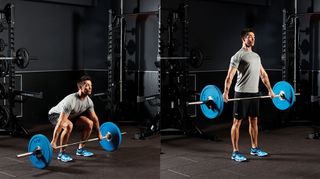
Sets 3 Reps 10 Rest 60sec
Why Because your grip’s wider in this move, you’ll need to move the bar through a larger range of motion, increasing the growth hormone hit.
How Hold a barbell with your hands roughly double shoulder-width apart. Push through your heels and keep your chest up as you drive your hips forwards to lift the bar.

Joe Warner is a highly experienced journalist and editor who began working in fitness media in 2008. He has featured on the cover of Men’s Fitness UK twice and has co-authored Amazon best-sellers including 12-Week Body Plan. He was the editor of Men’s Fitness UK magazine between 2016 and 2019, when that title shared a website with Coach.
